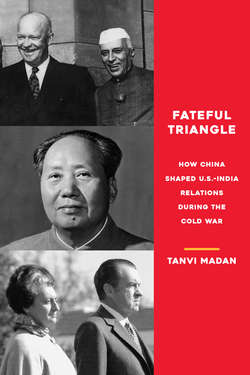Читать книгу Fateful Triangle - Tanvi Madan - Страница 20
На сайте Литреса книга снята с продажи.
2 Why So Wary? (1953–1956)
ОглавлениеWe did not come to an agreement about anything. I don’t mean to say we disagreed about everything. We didn’t try to come to an agreement.
—John Foster Dulles, US secretary of state, on his meeting with Jawaharlal Nehru in May 19531
It was obvious that we did not feel in the same way as the American Government about communism and the way to combat it … We felt that [the] American reaction to the communist countries was not only exaggerated and dangerous but actually was likely to produce the very opposite results than those aimed at, more especially in Asia.… American policy has led the United States to side with colonial and reactionary elements in Asia, and as a result of that, had almost presented to the communist countries an ideal opportunity to pose as liberating agencies. Mere force and threats of war might frighten people for a while, but would never succeed in convincing people.
—Jawaharlal Nehru, prime minister of India, to George Allen, April 24, 19542
During his 1949 visit to the United States, Nehru had received an honorary doctorate from Columbia University. In 1953, the man who had handed him that degree, former university president and retired general Dwight D. Eisenhower, became president of the United States. Despite their different backgrounds, Nehru and Eisenhower shared some views, including the need for balance between defense and development when thinking about national security. The Indian prime minister agreed with Eisenhower and Secretary of State John Foster Dulles’s view that military strength alone was not important; economic stability was essential as well. Furthermore, Eisenhower—like Nehru—believed that thinking in terms of unlimited means was not helpful; the resources to secure the country’s interests were limited, rather than expandable.
Between 1953 and 1956, however, shared concepts did not mean similar visions of how they should be put into practice. Nehru’s idea of containment-on-the-cheap, for example, envisioned engagement and negotiations. Eisenhower, on his part, believed that limited means necessitated burden sharing through alliances, and the use of more cost-effective instruments, such as nuclear weapons and covert action. Furthermore, while Eisenhower approved of the idea of negotiations, he left the details to Dulles, who saw negotiations as desirable only from a position of strength. In addition, Eisenhower and Dulles saw saber rattling—even of the nuclear kind—as acceptable instruments to demonstrate strength and deter adversaries. Nehru, however, thought it was provocative and counterproductive.
There were also areas where US-India perceptions continued to differ. For one, Eisenhower and Dulles asserted that the free world could afford no more losses to the communist world, that the battlefield was global, and that any loss would decrease American credibility and security. Moreover, unlike Indian officials, they saw communism as monolithic and incompatible with nationalism, and believed Beijing to be just an affiliate of Moscow. The administration also saw decolonization, which Nehru welcomed, as creating vulnerabilities that the communists could exploit. Furthermore, there was disapproval of neutral countries, which muddied the waters and created rifts in the free world that the communist world would manipulate.3
In most of Eisenhower’s first term, which this chapter covers, these differences contributed to or manifested themselves in persistent US-India disagreement on China. The two countries’ different attitudes and approaches toward that country were evident in the final stages and the aftermath of the Korean War, as well as in their debates over Indochina, American prisoners in China, and the Taiwan Strait crisis. And these developments took place as India’s partnership with China and the Soviet Union—and that of the US with Pakistan—evolved. Delhi’s and Washington’s differences on China had adverse consequences for the relationship—they deepened the rift between the US and India or, at the very least, prevented them from bridging the gap. This chapter examines those differences and their impact on the relationship. In a final section, it also considers why those disagreements did not lead to disengagement.
